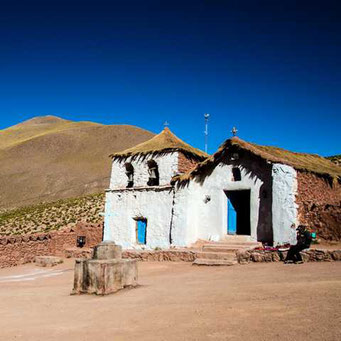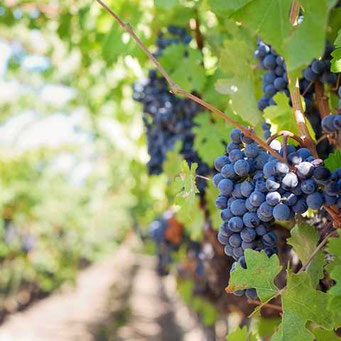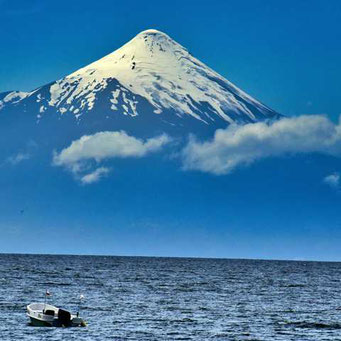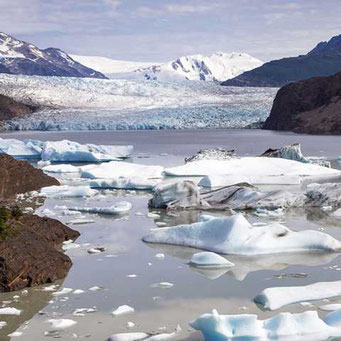Travel Destinations in Chile
From the massive Andes to the Pacific Ocean, from the mysterious Atacama Desert to the wilderness of Patagonia – we are Chile experts and present our second home: Chile and its variety of natural spectacles
The longest country in the world stretches for over 4,200 kilometers. In the east of Chile, the mighty Andes rise up. Majestic condors glide over the steep mountain ridges. Among the snow-covered Andean peaks are 2,085 volcanoes. Some of them tower far over 6,000 meters above sea level. And several volcanoes rumble vigorously. In turn, on the western side of the country, the powerful waves of the Pacific Ocean are crashing. The coast of Chile is adorned with branching fjords and hidden fishing villages, chic beach promenades and mystical islands. In the north, the silent Atacama Desert sets the rhythm. With its encrusted salt lakes and bubbling geysers, it seems like the terrain of another planet. Urban life takes place mainly in central Chile. Between the cities, rows of grapevines stretch endlessly across the green hills. Meanwhile, in the south, you sense the pure wilderness of the country. Shimmering lakes are surrounded by dense rainforest. And the ice of gigantic glaciers breaks clashingly. All this in one country – Chile is full of extremes.


The Great North:
- Arica and Iquique
-
Altiplano of the Andes
- San Pedro de Atacama
The Little North:
- Bahía Inglesa and Pan de Azúcar
- La Serena and Valle del Elqui
- Los Molles
Central Chile and Rapa Nui:
- Easter Island / Rapa Nui
- Valparaíso and Viña del Mar
- Capital Santiago
- Colchagua Valley and Talca
The Little South:
- Conguillío and Pucón
- Valdivia and Puerto Varas
- Island Chiloé
The Far South and Antarctica:
- Highway Carretera Austral
- Torres del Paine in southern Patagonia
- Tierra del Fuego
All in one Country – Chile and its Viewpoints
The Great North of Chile

The Little North of Chile

Central Chile and Rapa Nui

Full of craziness is the port city of Valparaíso, with its colorful hills, jerky elevators, and outstanding street art. Trundle along the attractive coastal promenade of the neighboring town of Viña del Mar. Inland, roam green palm forests in the ravishing Cerro La Campana National Park. Appreciate delicious wines and the relaxing atmosphere in the Casablanca Valley. On the Pacific coast of central Chile, you can relax in the tranquil coastal town of Quintay with its deserted sandy beach and enjoy local fish. Follow in the footsteps of poet Pablo Neruda in charming Isla Negra. And world-renowned surf spots with rural charm characterize Pichilemu. About 3,500 kilometers west of the Chilean mainland, the legendary Easter Island / Rapa Nui rises out of the sea. Devotional Moai statues as well as immense volcanic craters, the paradisiacal coastline and unsolved mysteries of history captivate you on the island. The capital Santiago is the complete contrast to this. The metropolis hums with its many faces, historic squares and magnificent city panoramas. Further south, immeasurable rows of flowering grapevines traverse the splendid Valle de Colchagua. Near Talca, you can discover the hidden Rainbow Waterfalls and the hiker's paradise of Altos de Lircay National Park. On a train ride on the Buscarril along the winding Maule River, you travel back in time to Constitución with its long stretched lava beaches. And it roars, bubbles and foams, while before your eyes the approx. 100 meter wide water mass of Saltos de Laja near Chillán and Concepción breaks without interruption about 40 meters into the depth.
The Little South of Chile

From Temuco towards the Andes lies one of Chile's most beautiful nature reserves: In Conguillío National Park you experience araucaria and colorful lagoons at the foot of the Llaima Volcano. Near Pucón, you get impressed by gushing streams of water, active volcanoes and the indigenous cultural heritage of the Mapuche. Nearby, Huerquehue National Park unfolds with its peaceful mountain lakes, immense forests and monumental volcanic sights. Further south, you discover the charming river landscapes and the townscape of Valdivia, formed by German immigrants. At the same altitude and not far from the Argentine border, the fairytale world of the Seven Lakes opens up around Panguipulli. Small villages dot the shores of crystal-clear waters, narrow hiking trails lead through intricate forests in the Huilo Huilo Nature Reserve. In the heart of the Lake Region, Puerto Varas is framed by cone-shaped volcanic peaks and picturesque waters. In Vicente Pérez Rosales National Park, the waterfalls of the Río Petrohué rage loudly. And on Chiloé, colorful stilt houses line the banks. Green hills and rugged cliffs adorn the landscape of Chile's second largest island. Wooden churches, declared a World Heritage Site by UNESCO, dominate the image of the villages, just as indigenous mythology influences the inhabitants of the archipelago.
The Far South of Chile and Antarctica

The legendary Carretera Austral Highway in northern Patagonia is flanked by centuries-old trees, winding fjords and dormant volcanoes. Here, Chaitén is a symbol of the beauty and drama of Chile's turbulent, active nature. Forested mountain landscapes and raging rivers are characteristic of the region around Futaleufú. With its warm thermal baths and German cultural relics, Puyuhuapi captivates you. And you get stumped by the massive hanging glacier Ventisquero Colgante in Queulat National Park. In the more southern part of the Carretera Austral, sharp mountain ridges cover Cerro Castillo National Park like towers of a medieval castle. The General Carrera Lake between Chile and Argentina exudes an aura of contemplation with its vastness and the snow-capped mountains on the horizon. The highlight of the shimmering waters are the eroded rock formations of the Capillas de Mármol. And in the deep south of Patagonia, immerse yourself in wild nature with massive mountains, turquoise lakes and voluminous glacial ice. Marvel at the spiky peaks of Las Torres, the beautiful Lago Nordenskjöld and the imposing Grey Glacier in the fabulous Torres del Paine National Park. Travel to Punta Arenas, one of the southernmost cities in the world, and observe the agile hustle and bustle of the King Penguins on Tierra del Fuego. And follow speechlessly the powerful sounds and elegant movements of the humpback whales in the Strait of Magellan.
Do you want advice?
Write us your travel wishes.
We tailor your journey through Chile.





















